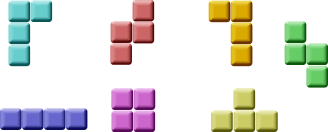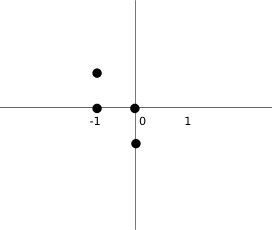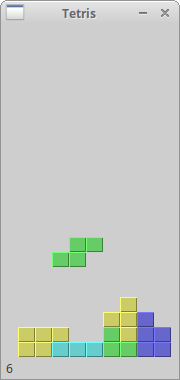The Tetris game in wxPython
last modified January 10, 2023
The Tetris game is one of the most popular computer games ever created. The original game was designed and programmed by a Russian programmer Alexey Pajitnov in 1985. Since then, Tetris is available on almost every computer platform in lots of variations.
Tetris is called a falling block puzzle game. In this game, we have seven different shapes called tetrominoes: S-shape, Z-shape, T-shape, L-shape, Line-shape, MirroredL-shape, and a Square-shape. Each of these shapes is formed with four squares. The shapes are falling down the board. The object of the Tetris game is to move and rotate the shapes so that they fit as much as possible. If we manage to form a row, the row is destroyed and we score. We play the Tetris game until we top out.

wxPython is a toolkit designed to create applications. There are other libraries which are targeted at creating computer games. Nevertheless, wxPython and other application toolkits can be used to create games.
The development
We do not have images for our Tetris game, we draw the tetrominoes using the drawing API available in wxPython. Behind every computer game, there is a mathematical model. So it is in Tetris.
Some ideas behind the game:
- We use
wx.Timerto create a game cycle - The tetrominoes are drawn
- The shapes move on a square by square basis (not pixel by pixel)
- Mathematically a board is a simple list of numbers
#!/usr/bin/env python
"""
ZetCode wxPython tutorial
This is Tetris game clone in wxPython.
author: Jan Bodnar
website: www.zetcode.com
last modified: July 2020
"""
import wx
import random
class Tetris(wx.Frame):
def __init__(self, parent):
wx.Frame.__init__(self, parent, size=(180, 380),
style=wx.DEFAULT_FRAME_STYLE ^ wx.RESIZE_BORDER ^ wx.MAXIMIZE_BOX)
self.initFrame()
def initFrame(self):
self.statusbar = self.CreateStatusBar()
self.statusbar.SetStatusText('0')
self.board = Board(self)
self.board.SetFocus()
self.board.start()
self.SetTitle("Tetris")
self.Centre()
class Board(wx.Panel):
BoardWidth = 10
BoardHeight = 22
Speed = 300
ID_TIMER = 1
def __init__(self, *args, **kw):
super(Board, self).__init__(*args, **kw)
self.initBoard()
def initBoard(self):
self.timer = wx.Timer(self, Board.ID_TIMER)
self.isWaitingAfterLine = False
self.curPiece = Shape()
self.nextPiece = Shape()
self.curX = 0
self.curY = 0
self.numLinesRemoved = 0
self.board = []
self.isStarted = False
self.isPaused = False
self.Bind(wx.EVT_PAINT, self.OnPaint)
self.Bind(wx.EVT_KEY_DOWN, self.OnKeyDown)
self.Bind(wx.EVT_TIMER, self.OnTimer, id=Board.ID_TIMER)
self.clearBoard()
def shapeAt(self, x, y):
return self.board[(y * Board.BoardWidth) + x]
def setShapeAt(self, x, y, shape):
self.board[(y * Board.BoardWidth) + x] = shape
def squareWidth(self):
return self.GetClientSize().GetWidth() // Board.BoardWidth
def squareHeight(self):
return self.GetClientSize().GetHeight() // Board.BoardHeight
def start(self):
if self.isPaused:
return
self.isStarted = True
self.isWaitingAfterLine = False
self.numLinesRemoved = 0
self.clearBoard()
self.newPiece()
self.timer.Start(Board.Speed)
def pause(self):
if not self.isStarted:
return
self.isPaused = not self.isPaused
statusbar = self.GetParent().statusbar
if self.isPaused:
self.timer.Stop()
statusbar.SetStatusText('paused')
else:
self.timer.Start(Board.Speed)
statusbar.SetStatusText(str(self.numLinesRemoved))
self.Refresh()
def clearBoard(self):
for i in range(Board.BoardHeight * Board.BoardWidth):
self.board.append(Tetrominoes.NoShape)
def OnPaint(self, event):
dc = wx.PaintDC(self)
size = self.GetClientSize()
boardTop = size.GetHeight() - Board.BoardHeight * self.squareHeight()
for i in range(Board.BoardHeight):
for j in range(Board.BoardWidth):
shape = self.shapeAt(j, Board.BoardHeight - i - 1)
if shape != Tetrominoes.NoShape:
self.drawSquare(dc,
0 + j * self.squareWidth(),
boardTop + i * self.squareHeight(), shape)
if self.curPiece.shape() != Tetrominoes.NoShape:
for i in range(4):
x = self.curX + self.curPiece.x(i)
y = self.curY - self.curPiece.y(i)
self.drawSquare(dc, 0 + x * self.squareWidth(),
boardTop + (Board.BoardHeight - y - 1) * self.squareHeight(),
self.curPiece.shape())
def OnKeyDown(self, event):
if not self.isStarted or self.curPiece.shape() == Tetrominoes.NoShape:
event.Skip()
return
keycode = event.GetKeyCode()
if keycode == ord('P') or keycode == ord('p'):
self.pause()
return
if self.isPaused:
return
elif keycode == wx.WXK_LEFT:
self.tryMove(self.curPiece, self.curX - 1, self.curY)
elif keycode == wx.WXK_RIGHT:
self.tryMove(self.curPiece, self.curX + 1, self.curY)
elif keycode == wx.WXK_DOWN:
self.tryMove(self.curPiece.rotatedRight(), self.curX, self.curY)
elif keycode == wx.WXK_UP:
self.tryMove(self.curPiece.rotatedLeft(), self.curX, self.curY)
elif keycode == wx.WXK_SPACE:
self.dropDown()
elif keycode == ord('D') or keycode == ord('d'):
self.oneLineDown()
else:
event.Skip()
def OnTimer(self, event):
if event.GetId() == Board.ID_TIMER:
if self.isWaitingAfterLine:
self.isWaitingAfterLine = False
self.newPiece()
else:
self.oneLineDown()
else:
event.Skip()
def dropDown(self):
newY = self.curY
while newY > 0:
if not self.tryMove(self.curPiece, self.curX, newY - 1):
break
newY -= 1
self.pieceDropped()
def oneLineDown(self):
if not self.tryMove(self.curPiece, self.curX, self.curY - 1):
self.pieceDropped()
def pieceDropped(self):
for i in range(4):
x = self.curX + self.curPiece.x(i)
y = self.curY - self.curPiece.y(i)
self.setShapeAt(x, y, self.curPiece.shape())
self.removeFullLines()
if not self.isWaitingAfterLine:
self.newPiece()
def removeFullLines(self):
numFullLines = 0
statusbar = self.GetParent().statusbar
rowsToRemove = []
for i in range(Board.BoardHeight):
n = 0
for j in range(Board.BoardWidth):
if not self.shapeAt(j, i) == Tetrominoes.NoShape:
n = n + 1
if n == 10:
rowsToRemove.append(i)
rowsToRemove.reverse()
for m in rowsToRemove:
for k in range(m, Board.BoardHeight):
for l in range(Board.BoardWidth):
self.setShapeAt(l, k, self.shapeAt(l, k + 1))
numFullLines = numFullLines + len(rowsToRemove)
if numFullLines > 0:
self.numLinesRemoved = self.numLinesRemoved + numFullLines
statusbar.SetStatusText(str(self.numLinesRemoved))
self.isWaitingAfterLine = True
self.curPiece.setShape(Tetrominoes.NoShape)
self.Refresh()
def newPiece(self):
self.curPiece = self.nextPiece
statusbar = self.GetParent().statusbar
self.nextPiece.setRandomShape()
self.curX = Board.BoardWidth // 2 + 1
self.curY = Board.BoardHeight - 1 + self.curPiece.minY()
if not self.tryMove(self.curPiece, self.curX, self.curY):
self.curPiece.setShape(Tetrominoes.NoShape)
self.timer.Stop()
self.isStarted = False
statusbar.SetStatusText('Game over')
def tryMove(self, newPiece, newX, newY):
for i in range(4):
x = newX + newPiece.x(i)
y = newY - newPiece.y(i)
if x < 0 or x >= Board.BoardWidth or y < 0 or y >= Board.BoardHeight:
return False
if self.shapeAt(x, y) != Tetrominoes.NoShape:
return False
self.curPiece = newPiece
self.curX = newX
self.curY = newY
self.Refresh()
return True
def drawSquare(self, dc, x, y, shape):
colors = ['#000000', '#CC6666', '#66CC66', '#6666CC',
'#CCCC66', '#CC66CC', '#66CCCC', '#DAAA00']
light = ['#000000', '#F89FAB', '#79FC79', '#7979FC',
'#FCFC79', '#FC79FC', '#79FCFC', '#FCC600']
dark = ['#000000', '#803C3B', '#3B803B', '#3B3B80',
'#80803B', '#803B80', '#3B8080', '#806200']
pen = wx.Pen(light[shape])
pen.SetCap(wx.CAP_PROJECTING)
dc.SetPen(pen)
dc.DrawLine(x, y + self.squareHeight() - 1, x, y)
dc.DrawLine(x, y, x + self.squareWidth() - 1, y)
darkpen = wx.Pen(dark[shape])
darkpen.SetCap(wx.CAP_PROJECTING)
dc.SetPen(darkpen)
dc.DrawLine(x + 1, y + self.squareHeight() - 1,
x + self.squareWidth() - 1, y + self.squareHeight() - 1)
dc.DrawLine(x + self.squareWidth() - 1,
y + self.squareHeight() - 1, x + self.squareWidth() - 1, y + 1)
dc.SetPen(wx.TRANSPARENT_PEN)
dc.SetBrush(wx.Brush(colors[shape]))
dc.DrawRectangle(x + 1, y + 1, self.squareWidth() - 2,
self.squareHeight() - 2)
class Tetrominoes(object):
NoShape = 0
ZShape = 1
SShape = 2
LineShape = 3
TShape = 4
SquareShape = 5
LShape = 6
MirroredLShape = 7
class Shape(object):
coordsTable = (
((0, 0), (0, 0), (0, 0), (0, 0)),
((0, -1), (0, 0), (-1, 0), (-1, 1)),
((0, -1), (0, 0), (1, 0), (1, 1)),
((0, -1), (0, 0), (0, 1), (0, 2)),
((-1, 0), (0, 0), (1, 0), (0, 1)),
((0, 0), (1, 0), (0, 1), (1, 1)),
((-1, -1), (0, -1), (0, 0), (0, 1)),
((1, -1), (0, -1), (0, 0), (0, 1))
)
def __init__(self):
self.coords = [[0,0] for i in range(4)]
self.pieceShape = Tetrominoes.NoShape
self.setShape(Tetrominoes.NoShape)
def shape(self):
return self.pieceShape
def setShape(self, shape):
table = Shape.coordsTable[shape]
for i in range(4):
for j in range(2):
self.coords[i][j] = table[i][j]
self.pieceShape = shape
def setRandomShape(self):
self.setShape(random.randint(1, 7))
def x(self, index):
return self.coords[index][0]
def y(self, index):
return self.coords[index][1]
def setX(self, index, x):
self.coords[index][0] = x
def setY(self, index, y):
self.coords[index][1] = y
def minX(self):
m = self.coords[0][0]
for i in range(4):
m = min(m, self.coords[i][0])
return m
def maxX(self):
m = self.coords[0][0]
for i in range(4):
m = max(m, self.coords[i][0])
return m
def minY(self):
m = self.coords[0][1]
for i in range(4):
m = min(m, self.coords[i][1])
return m
def maxY(self):
m = self.coords[0][1]
for i in range(4):
m = max(m, self.coords[i][1])
return m
def rotatedLeft(self):
if self.pieceShape == Tetrominoes.SquareShape:
return self
result = Shape()
result.pieceShape = self.pieceShape
for i in range(4):
result.setX(i, self.y(i))
result.setY(i, -self.x(i))
return result
def rotatedRight(self):
if self.pieceShape == Tetrominoes.SquareShape:
return self
result = Shape()
result.pieceShape = self.pieceShape
for i in range(4):
result.setX(i, -self.y(i))
result.setY(i, self.x(i))
return result
def main():
app = wx.App()
ex = Tetris(None)
ex.Show()
app.MainLoop()
if __name__ == '__main__':
main()
The game is simplified a bit so that it is easier to understand. It starts immediately after the application is launched. We can pause the game by pressing the p key. The Space key drops the falling Tetris piece immediately to the bottom. The d key drops the piece one line down. (It can be used to speed up the falling.) The game goes at constant speed, no acceleration is implemented. The score is the number of lines that we have removed.
def __init__(self, *args, **kw):
super(Board, self).__init__(*args, **kw)
A note for Windows users. If you cannot use the arrow keys, add
style=wx.WANTS_CHARS to the board constructor.
... self.curX = 0 self.curY = 0 self.numLinesRemoved = 0 self.board = [] ...
Before we start the game cycle, we initialize some important variables.
The self.board variable is a list of numbers from 0 ... 7. It represents
the position of various shapes and remains of the shapes on the board.
for i in range(Board.BoardHeight):
for j in range(Board.BoardWidth):
shape = self.shapeAt(j, Board.BoardHeight - i - 1)
if shape != Tetrominoes.NoShape:
self.drawSquare(dc,
0 + j * self.squareWidth(),
boardTop + i * self.squareHeight(), shape)
The painting of the game is divided into two steps. In the first step, we
draw all the shapes, or remains of the shapes that
have been dropped to the bottom of the board. All the squares are rememberd
in the self.board list variable.
We access it using the shapeAt() method.
if self.curPiece.shape() != Tetrominoes.NoShape:
for i in range(4):
x = self.curX + self.curPiece.x(i)
y = self.curY - self.curPiece.y(i)
self.drawSquare(dc, 0 + x * self.squareWidth(),
boardTop + (Board.BoardHeight - y - 1) * self.squareHeight(),
self.curPiece.shape())
The next step is drawing of the actual piece that is falling down.
elif keycode == wx.WXK_LEFT:
self.tryMove(self.curPiece, self.curX - 1, self.curY)
In the OnKeyDown() method we check for pressed keys. If we
press the left arrow key, we try to move the piece to the left. We say
try because the piece might not be able to move.
def tryMove(self, newPiece, newX, newY):
for i in range(4):
x = newX + newPiece.x(i)
y = newY - newPiece.y(i)
if x < 0 or x >= Board.BoardWidth or y < 0 or y >= Board.BoardHeight:
return False
if self.shapeAt(x, y) != Tetrominoes.NoShape:
return False
self.curPiece = newPiece
self.curX = newX
self.curY = newY
self.Refresh()
return True
In the tryMove() method we try to move our shapes. If the shape
is at the edge of the board or is adjacent to some
other piece, we return False; otherwise we place the current falling
piece to a new position and return True.
def OnTimer(self, event):
if event.GetId() == Board.ID_TIMER:
if self.isWaitingAfterLine:
self.isWaitingAfterLine = False
self.newPiece()
else:
self.oneLineDown()
else:
event.Skip()
In the OnTimer() method we either create a new piece, after the
previous one was dropped to the bottom, or we move a falling piece one line down.
def removeFullLines(self):
numFullLines = 0
rowsToRemove = []
for i in range(Board.BoardHeight):
n = 0
for j in range(Board.BoardWidth):
if not self.shapeAt(j, i) == Tetrominoes.NoShape:
n = n + 1
if n == 10:
rowsToRemove.append(i)
rowsToRemove.reverse()
for m in rowsToRemove:
for k in range(m, Board.BoardHeight):
for l in range(Board.BoardWidth):
self.setShapeAt(l, k, self.shapeAt(l, k + 1))
...
If the piece hits the bottom, we call the removeFullLines() method.
First we find out all full lines and remove them. We do it by moving all
lines above the current full line to be removed one line down. Notice that we
reverse the order of the lines to be removed. Otherwise, it would not work correctly.
In our case we use a naive gravity. This means that the pieces may
be floating above empty gaps.
def newPiece(self):
self.curPiece = self.nextPiece
statusbar = self.GetParent().statusbar
self.nextPiece.setRandomShape()
self.curX = Board.BoardWidth / 2 + 1
self.curY = Board.BoardHeight - 1 + self.curPiece.minY()
if not self.tryMove(self.curPiece, self.curX, self.curY):
self.curPiece.setShape(Tetrominoes.NoShape)
self.timer.Stop()
self.isStarted = False
statusbar.SetStatusText('Game over')
The newPiece() method creates randomly a new tetris piece.
If the piece cannot go into its initial position, the game is over.
The Shape class saves information about the tetris piece.
self.coords = [[0,0] for i in range(4)]
Upon creation we create an empty coordinates list. The list will save the coordinates of the Tetris piece. For example, the tuples (0, -1), (0, 0), (-1, 0), (-1, -1) represent a rotated S-shape. The following diagram illustrates the shape.

When we draw the current falling piece, we draw it at self.curX and
self.curY position. Then we look at the coordinates table and draw
all the four squares.

This was a Tetris game in wxPython.